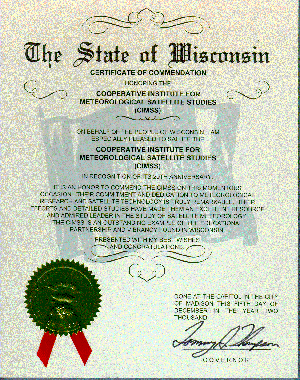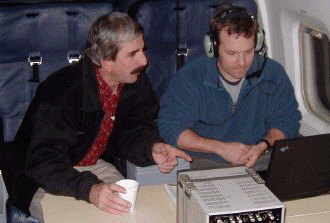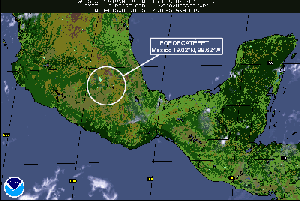Monthly News Summary – January 2001
Ice Work
by Terri Gregory, SSEC Public Information Coordinator
January 2001
This column includes news received in December.
The Why? Files draws from SSEC’s proposed CIRRUS project in “A Winter’s Tale,” posted December 7. Here you’ll learn more about snow and ice crystals and cirrus clouds than you thought was possible. The five-part feature explains the processes producing snow and ice and features a nifty Java applet which lets you make your own snowflake. Tom Whittaker produced the interactive Java applet. SSEC’s Schwerdtfeger Library provided snowflake pictures and information on Snowflake Bentley, first to photograph individual snow crystals. Among those included in the feature are atmospheric physicist Pao Wang (UW–Madison’s AOS) and Steve Ackerman (CIMSS and AOS) who explained the role of cirrus clouds in climate.
In early January, readers of the Milwaukee Journal Sentinel will have their own connection to Antarctica as photojournalist Ernie Mastroianni journeys to “The Ice.” Ernie may interview Wisconsin’s own Antarctica researchers, including several from the University of Wisconsin–Madison. Under lead driller Jay Kyne, SSEC’s new Ice Coring and Drilling Services supports the research of geophysicists Mark Battle (Bowdoin College, Brunswick, Maine) and Michael Bender (Princeton University). According to Project Coordinator Tony Wendricks, the crew stops first at McMurdo Station for several days of snow survival training before venturing to the South Pole. There they will drill holes to sample air trapped in firn, snow older than a year that is being compressed into glacial ice. The ice cores themselves will be saved for a researcher at South Dakota State for a 1000-year record of volcanic dust and for the National Ice Core Laboratory for future projects. At UW–Madison, Professor Emeritus Charles Bentley (Geology/Geophysics) is principal investigator of SSEC’s Ice Coring and Drilling Services. Bob Paulos (SSEC) is program manager. ICDS provides ice-coring and drilling services to NSF-sponsored researchers in polar regions and at high-altitude sites around the world.
Ernie may also interview researchers who are servicing and installing Antarctica’s network of Automatic Weather Stations including those on icebergs that broke from the Ross Ice Shelf starting in March. Besides providing education and delight to countless viewers of satellite imagery on the Web, the icebergs provide a moving laboratory to glaciologists and polar weather experts. SSEC researcher Jonathan Thom and Rob Flint will install location systems that consist of GPS and meteorological sensors, possibly on icebergs B-15A and C-16. According to principal investigator Chuck Stearns, the exact location will be determined when the men arrive near the icebergs and know more about iceberg and weather conditions. Rob Flint is a veteran Antarctic engineer who works occasionally on SSEC projects.
SSEC’s Antarctic Meteorological Research Center provided information for a short pictorial in the New York Times. The AMRC’s Matthew Lazzara gave details to reporter Dennis Overbye of the Ross Iceshelf icebergs, especially B-15 and its offspring. The piece was printed November 30, without attribution and with some inaccurate sizes. If you need size information, AMRC can provide it.
CIMSS’ 20th Year
For More Information
The Cooperative Institute for Meteorological Satellite Studies observed its 20th anniversary on December 14, and celebrated the reception of data from NASA’s earth science satellite, Terra. Tim Kelley of UW–Madison’s University Communications released a news brief on December 6 with a timely lead, drawing attention to the “latest advance.” It appeared in Wisconsin Week Wire for December 13. The celebration and our research with MODIS data was featured on WIBA Radio and on Madison’s WISC-TV Channel 15 on December 14 and 15.
The CIMSS Board of Directors helped dedicate the newest rooftop antenna, this one inside a round radome atop a 40 foot tower, receiving MODIS data from as far north as James Bay in Canada to the Yucatan Peninsula in Central America in 36 spectral bands (wavelengths). A patch of snowy rooftop was swept a little cleaner for the eminent feet. SSEC’s Liam Gumley, MODIS software developer, explained that SSEC was the only direct broadcast site for MODIS data in the midwestern U.S. The rooftop dedication was followed by talks at the State Historical Society from William L. Smith, CIMSS director for 13 years, who now leads atmospheric science research at NASA’s Langley Research Center, and Paul Menzel, chief scientist in NOAA’s National Environmental Satellite, Data, and Information Service. At a Pyle Center reception, Graduate School Dean Virginia Hinshaw presented a commemorative plaque to current CIMSS director Steven Ackerman. SSEC director Henry Revercomb read celebratory remarks by Wisconsin Governor Tommy Thompson.
 |
Click on the small image to read the words of the Governor’s Commendation. |
It was a day to rededicate the institute founded in joint agreement by the university and federal government (NOAA) to the memory of Professor Verner Suomi, its first director. Professor Suomi, who died in summer 1995, would encourage the current group of atmospheric scientists to look ahead toward continual breakthroughs in the science of satellite meteorology.
AFWEX Support
For More Information
CIMSS supported the recent AFWEX experiment at the Department of Energy’s Atmospheric Radiation Measurement Program site in Oklahoma with real-time weather forecasts. Bob Aune (NOAA) generated forecasts of clouds and water vapor in 27 km resolution to support the field experiment’s flight operations using the CIMSS Regional Assimilation System (CRAS). AFWEX, which stands for Atmospheric Radiation Measurement First ISCCP (International Satellite Cloud Climatology Project) Regional field Experiment Water Vapor Experiment, used instruments on NASA’s DC-8 to obtain accurate measurements of upper tropospheric water vapor to prepare for the arrival of high-spectral resolution infrared measurements from space. CRAS is the only real-time forecast/assimilation system that utilizes cloud information from GOES sounders. Feedback from flight forecasters was generally positive.
Tinker Take-Off, weekly newspaper of Tinker AFB, where NASA’s DC-8 was based during AFWEX, published a long article about the experiment on its last day, December 15. Reporter Darren Heusel interviewed Dave Tobin, who participated in AFWEX with a crew from SSEC, led by Hank Revercomb, co-investigator for the Scanning High resolution Interferometer Sounder and the Atmospheric Emitted Radiance Interferometer and lead scientist for AFWEX.
 |
AFWEX lead scientist Hank Revercomb and mission scientist Dave Tobin monitor the Scanning-HIS on the November 29 flight, from within NASA’s DC-8. The S-HIS is mounted under the plane. |
Because the Air Force Base hosted the DC-8, it was featured prominently. The reporter noted that “the DC-8 complements and extends the range of any instrument package, allowing scientists to successfully address today’s planetary issues, like global warming… .” SSEC’s Scanning HIS flew on the DC-8 while the AERI took measurements from the ground. Dave Tobin noted that, “What we’re really doing is trying to test how well these measurements agree with one another.”
Research News
For More Information
CIMSS researchers Scott Bachmeier, Suzanne Wetzel and Tom Whittaker have extended VISITView software by integrating audio and annotation recording and playback features, so that pre-recorded audio and drawing actions can be added to instructional components. The Virtual Institute for Satellite Integration Training, or VISIT, was established to accelerate the transfer of remotely-sensed research results into NWS operations. VISIT utilizes distance learning techniques, including the World-Wide Web, to accomplish that end. SSEC’s CIMSS researchers developed VISITView software to demonstrate how NWS forecasters can use data, primarily radar, satellite imagery, and model output, in their forecasts.
For the National Weather Service, Tony Schreiner (SSEC/CIMSS) and Tim Schmit (NOAA) have calculated a conversion look-up table for Tony’s Sounder Cloud Top Pressure Derived Product Image. This look-up table allows conversion from counts (0-255) to pressure, meters (for the standard atmosphere), and feet. The table will be incorporated into the NWS Advanced Weather Interactive Processing System to allow forecasters to obtain cloud height measurements in feet.
In collaboration with NASA researcher Bryan Baum, CIMSS researchers Tony Schreiner, Jim Nelson and Gail Bayler produced a data set using GOES sounder cloud data for a case study of Hurricane Nora. The data set is utilized by the Global Energy and Water cycle EXperiment (GEWEX) Cloud System Study Working Group #2 that focuses on comparisons of cirrus cloud models and parameterizations. Ken Sassen (University of Utah) leads the effort to organize case studies that will be used to initialize different cloud models.
Throughout much of December, Elaine Prins (NOAA) and Chris Schmidt (CIMSS) detected Mexico’s Popocatepetl volcano as a hot spot in the GOES-8 Wildfire Automated Biomass Burning Algorithm (ABBA) half-hourly fire product. The diurnal Wildfire ABBA fire product showed variations in the intensity of the Popocatepetl hot spot as observed in the 3.9 micron brightness temperature and the 3.9 minus 10.7 micron brightness temperature difference. In mid-December, animations of the GOES-8 Wildfire ABBA product documented increased hot spot and plume activity. These observations suggest the possibility of using a variation of the Wildfire ABBA for real-time identification and monitoring of volcanic hot spot activity.
 |
Mexico’s Popocatepetl volcano is detected as a hot spot in this GOES image. Click on the picture to see the animation. |
In Print
For More InformationJim Carrier began his book, The Ship and the Storm: Hurricane Mitch and Loss of theFantome, in 1999. McGraw-Hill’s International Marine division just published it. The book reconstructs what must have happened to the Windjammer sailing ship, Fantome, as its captain tried to outmaneuver the storm in October 1998. The CIMSS Tropical Cyclones group provided imagery and expertise, along with many other experts. The book is excellently researched and reads like a fast-paced novel. It is peppered with conversations, like those of researchers in the Hurricane Research Division as they beg to fly into the eyewall of this Category 5 storm, because they’ve never done it before. And you’ll like the description that starts with, “So secure was the National Hurricane Center that forecasters were sometimes surprised, upon leaving their shifts …, to find an overhead thunderstorm booming and pelting rain.” (p.67) The book is in The Schwerdtfeger Library. There’s a short waiting list.
The Wisconsin Engineer, awarding winning magazine published by students in UW–Madison’s College of Engineering, featured SSEC’s new X-band antenna in its November 2000 issue. Reporter Nicholas Mueller, sophomore in Materials Science and Engineering, focused on the capabilities of MODIS, the instrument on NASA’s Terra satellite sending its data to the antenna. Nicholas noted that MODIS data is used “to link isolated events in the climate into a more complete ‘system’ picture of the climate… .”
The International Space Station is now visible in its nearly nightly overpass of Madison and other locales. The Associated Press interviewed Sanjay Limaye for the December 14Wisconsin State Journal. Sanjay explained that the station with solar panels newly unfurled would “look like a star that is moving.”
The University Corporation for Atmospheric Research used a Hurricane Mitch image from the CIMSS Web site in the brochure, “A National Priority: Building Resilience to Natural Hazards.” Bob Henson, UCAR Communications, said that the short brochure is produced with the American Meteorology Society “to help raise awareness in Washington (especially among incoming Congressional staff) of current issues in weather and climate research.”
SSEC is included in the International Satellite Directory for 2001. In its sixth year of publication, the publisher says the directory has become the industry standard. “With over 20,000 active readers in 150 countries,” they say, “this is your opportunity to represent your services and/or products to these potential customers FREE OF CHARGE [sic].”
Broadcast
For More Information
On the December 28 appearance of Weather Guys Steve Ackerman and Jonathan Martin on WHA Radio, Jon cheerfully declared that this is the coldest winter in ten years, and, with all the snow, a skier’s delight, at least in southern Wisconsin, so far. Pressing his luck, Jon continued: Madison’s temperature is 11.2 degrees below normal, and, if it holds for four more days, it will be the coldest December on record. Steve joined in via phone from a ski vacation in up-state New York with the “good news”—the snowfall will offset a drop in Great Lake water levels. Wisconsin’s intelligent listeners asked the usual questions plus some climatologically timely ones, including: how much and what kinds of snow will a particular spot in Wisconsin have this winter? Like any good oracle, the Weather Guys deftly sidestepped the question: “yes, we’ll have lots of snow.” And they commented on the perils of having to forecast exact amounts of snow—no wonder National Weather Service forecasts are off by a couple inches here and there!
On the Net
For More Information
Space ScienceSSEC is listed with a few special space science sites in Vic Stathopoulos’Aerospaceguide. If you visit, save the bookmark; it’s hard to find your way back from the home page. Vic has some interesting lists of links, including one for Women in Space, under Space History. It may be hard to find your way around the Web site, but Vic answers email very promptly, should you get lost. Vic manages this complex site from a Web café in Dublin, Ireland.
